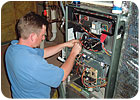This report is good news to manufacturers rolling out their new, super-high-efficiency, 95 percent-plus AFUE furnaces this year. These new furnaces are designed to appeal to consumers who are looking to lower their utility bills, as well as improve their comfort. An added selling point is that 95 percent AFUE furnaces qualify for the Federal Tax Credit for Energy Efficiency.
The new breed of super-high-efficiency furnace not only features lower operating costs, it is also typically outfitted with all sorts of bells and whistles, including two-stage operation, variable-speed technology, and a smart controller. Manufacturers state that demand is strong for these high-end furnaces, and they expect sales to continue to increase as customers opt for heating equipment that will keep them warm without running up their utility bill.

ENERGY-EFFICIENCY DEMANDS
High-efficiency furnaces in the 95 percent-AFUE range are definitely more expensive than 80 or 90 percent efficient furnaces, but consumers usually don't balk at the price when they find out what the payback will be. Matt Lattanzi, product manager, Nordyne, O'Fallon, Mo., noted that the highest-efficiency furnaces cost about 10 percent more than a 90 percent furnace, but the payback period can be short depending on where a homeowner lives."In 2005, the national average for natural gas was $1.09 per therm. In the St. Louis metropolitan area, a homeowner running an 80 percent furnace would pay $2,193 in energy costs on an annual basis for that furnace, assuming 2,009 heating hours per year," said Lattanzi. "With a 95 percent furnace, it would cost $1,847 annually to run that furnace, so the savings would be $346 a year."
Nordyne recently launched its 95.1 percent AFUE gas furnaces in the Maytag, Westinghouse, Frigidaire, and Tappan lines. Standard features include two-stage operation, a two-speed inducer, two-stage timer, and the GE ECM variable-speed motor. Lattanzi noted that these offerings are just the beginning and that more high-end, high-efficiency furnaces will be making their debut toward the end of the year.
Tim Perry, manager of residential heating product management, Carrier, Indianapolis, said the company's Infinity 96â„¢ furnace, with AFUE ratings of up to 96.6 percent, is also meeting consumer demand for energy efficiency. "Our Serpentuffâ„¢ secondary heat exchanger design provides excellent heat transfer while at the same time requires less electrical usage from the blower, providing utility savings beyond the 96.6 percent AFUE."
The Infinity furnace features two-stage operation, variable-speed technology, Infinityâ„¢ Intelligence (which requires only four control wires to be connected to an Infinity user interface), and is compatible with the Hybrid Heatâ„¢ system. Perry noted that customers are clearly willing to pay the difference for their high-end furnace, "as a greater percentage are choosing the Infinity 96, along with our Infinity Series heat pumps and Infinity user Interface."
Also introducing a 95 percent-plus efficient furnace this year are Rheem and Ruud. Karla Lynn, residential indoor product manager, Rheem Heating and Cooling Division, Fort Smith, Ark., noted that the Rheem [Ruud] GRL Model is a two-stage premium furnace that operates at 70 percent of capacity at low fire and 100 percent of capacity on high fire.
"It is compatible with single- or two-stage thermostats and includes stainless steel heat exchangers, humidifier and EAC hookups on the integrated control board, quiet-operating inducer motor, control board diagnostics, and transformer with control fuse protection," said Lynn.
The price of fossil fuels has definitely accelerated the shift from 80-90 percent furnaces, noted Lynn, and consumers are increasingly realizing a better payback over the life of the product than less-efficient models that were popular just five years ago.

BETTER COMFORT, WARRANTIES
While saving energy may be the primary reason why consumers purchase 95 percent plus efficient furnaces, their ability to provide better comfort shouldn't be overlooked. In addition, the highest-efficiency furnaces come with longer warranties, meaning consumers have peace of mind when purchasing the higher-priced equipment.Lattanzi stated that better comfort is a definite selling point for high-efficiency furnaces. "With the variable speed there's better temperature control, and it's also quieter, particularly on ramp-up. In the colder climates, the furnaces sell based on energy efficiency. In the warmer climates, they often sell on comfort."
Perry added that with the Infinity 96, "Comfort is maximized through ComfortHeatâ„¢ technology, which provides longer, more even heating cycles. And with the 100 percent satisfaction guarantee that a Carrier Factory Authorized Dealer can offer, customers know they've made an excellent choice."
The 95 percent efficient Maytag furnace comes with the dependability promise, which states that if the heat exchanger fails for the original owner, the entire furnace will be replaced. "We offer the same warranty for Frigidaire, Tappan, and Westinghouse brands, but it's called the quality pledge. Nordyne offers one of the best furnace warranties in the industry," said Lattanzi.
As more consumers look to their furnaces for better comfort and lower energy costs, the shift will continue toward higher-efficiency furnaces. As Lynn noted, "Today, we are seeing that meeting the specific comfort and health expectations of homeowners plays a much larger role than price in the buyer's final selection.
"It is true that premium efficiency furnaces and indoor air quality accessories increase the total sale price and profit margins, but the most important observation is the increasing levels of customer satisfaction earned as a result of custom tailoring equipment solutions to consumer expectations."
For more information ,visit www.carrier.com, www.rheem.com, and www.nordyne.com.
Publication date: 11/20/2006


Report Abusive Comment